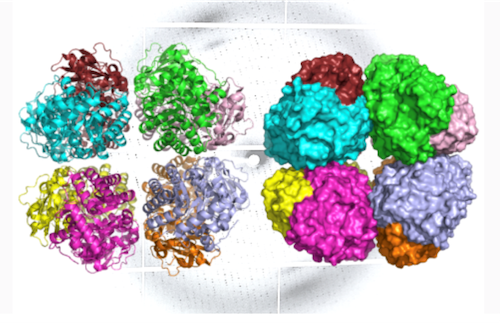“Missing Link” in Evolutionary History of the Carbon-Fixing Protein Rubisco
10/07/2020

A ribbon diagram (left) and molecular surface representation (right) of carbon-fixing form I' Rubisco, shows eight molecular subunits without the small subunits. An x-ray diffraction pattern of the enzyme appears in the background. [Courtesy Lawrence Berkeley National Laboratory]
The Summary
Researchers have discovered a unique, ancient version of Rubisco, the most abundant enzyme on Earth and critical to life as we know it. Found in previously unknown environmental microbes, the newly identified Rubisco lineage, called form I’ Rubisco, provides insight into the evolution of the photosynthetic organisms that underlie global food chains.
Contributing to this discovery were scientists at the Structurally Integrated Biology for the Life Sciences (SIBYLS) beamline 12.3.1, located at Lawrence Berkeley National Laboratory’s Advanced Light Source. By analyzing size-exclusion chromatography/small-angle X-ray scattering (SEC-SAXS) data collected at SIBYLS, the team was able to capture how the enzyme’s structure changes during different states of activity.
Related Links
- BER Resource: Structurally Integrated Biology for the Life Sciences
- News: Study Finds "Missing Link" in the Evolutionary History of Carbon-Fixing Protein Rubisco
References
Banda, D. M., et al. 2020. “Novel Bacterial Clade Reveals Origin of Form I Rubisco,” Nature Plants 6, 1158–66. [DOI:10.1038/s41477-020-00762-4]
